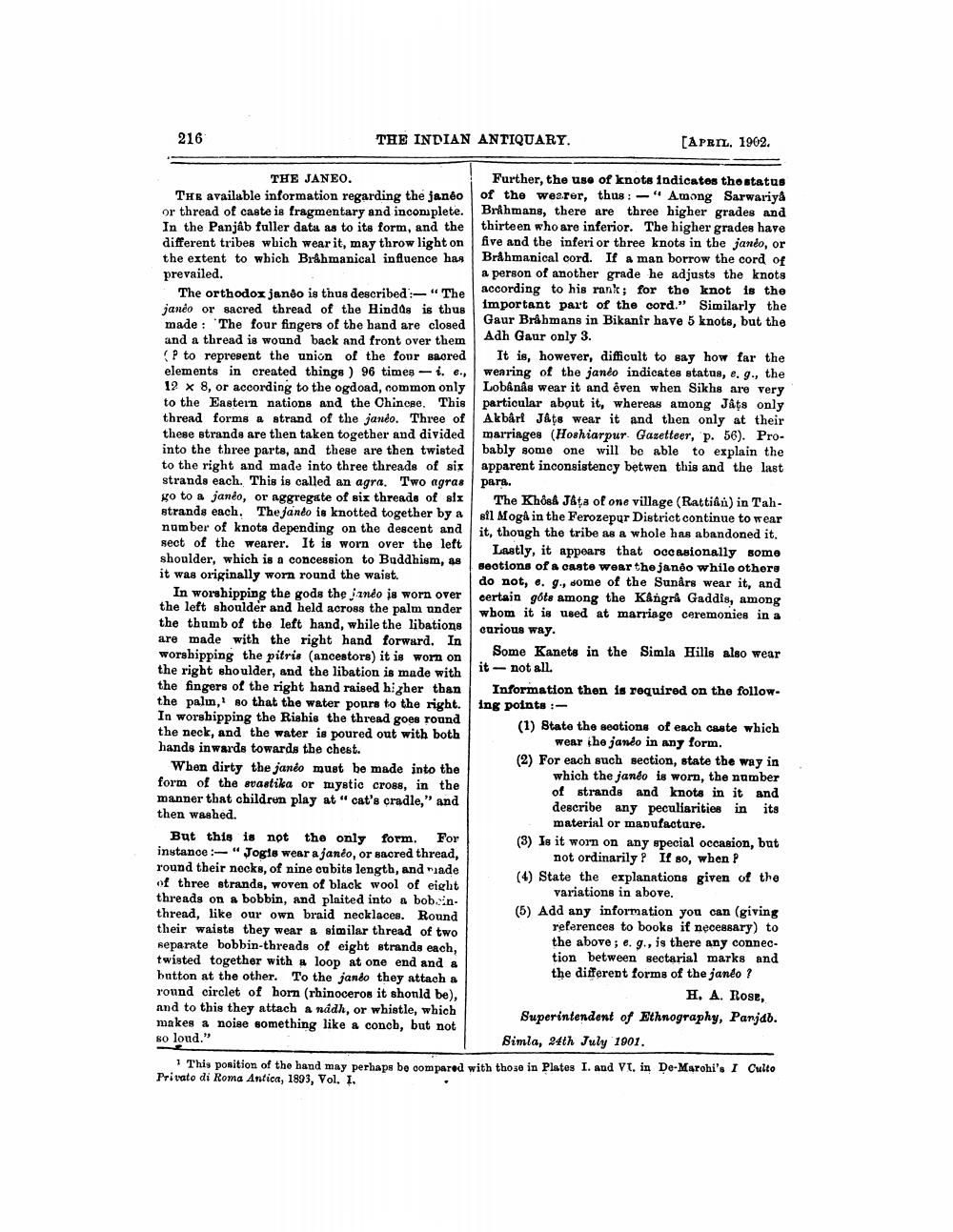________________
216
THE INDIAN ANTIQUARY.
[APRIL, 1902.
THE JANEO.
Further, the use of knots indicates the status The available information regarding the janeo of the wearer, thus: -"Among Sarwariya or thread of caste is fragmentary and inconsplete. Brahmans, there are three higher grades and In the Panjab faller data as to its form, and the thirteen who are inferior. The higher grades have different tribes which wear it, may throw light on five and the inferi or three knots in the jando, or the extent to which Brahmanical influence has Brahmanical cord. If a man borrow the cord of prevailed.
a person of another grade he adjusts the knots The orthodox jando is thus described "The
according to his rank; for the knot is the janeo or sacred thread of the Hindds is thus
Important part of the cord." Similarly the
Gaur Brahmans in Bikanir have 5 knots, but the made : The four fingers of the band are closed and a thread is wound back and front over them
Adh Gaur only 3. (P to represent the union of the four sacred It is, however, difficult to say how far the elements in created things ) 96 times - i. e., wearing of the janeo indicates status, e.g., the 12 x 8, or according to the ogdoad, common only Lobânâs wear it and even when Sikhs are very to the Eastern nations and the Chinese. This particular about it, whereas among Játs only thread forms a strand of the jando. Three of Akbar Játs wear it and then only at their these strands are then taken together and divided marriages (Hoshiarpur Gazetteer, p. 56). Prointo the three parts, and these are then twisted bably some one will be able to explain the to the right and made into three threads of six apparent inconsistency betwen this and the last strands each. This is called an agra. Two agras para. go to a janeo, or aggregate of six threads of six The Khoes Jata of one village (Rattian) in Tahstrands each. The fando is knotted together by a sil Moga in the Ferozepur District continue to wear number of knots depending on the descent and it, though the tribe as a whole has abandoned it. sect of the wearer. It is worn over the left
Lastly, it appears that occasionally somo shoulder, which is a concession to Buddhism, as
Beotions of caste wear the jango while others it was originally worn round the waist.
do not, e. 9., some of the Sunårs wear it, and In worshipping the gods the jando is worn over certain góta among the Kangrå Gaddis, among the left shoulder and held across the palm under
wbom it is used at marriage ceremonies in a the thumb of the left hand, while the libations
curious way. are made with the right hand forward. In worshipping the pitris (ancestors) it is worn on
Some Kanets in the Simla Hills also wear the right shoulder, and the libation is made with
it - not all. the fingers of the right hand raised higher than Information then is required on the followthe palun, so that the water pours to the right. ing points:In worshipping the Rishis the thread goes round
(1) State the sections of each caste which the neck, and the water is poured out with both
wear he janeo in any form. hands inwards towards the chest.
(2) For each such section, state the way in When dirty the janeo must be made into the
which the janeo is worn, the number form of the wastika or mystic cross, in the
of strands and knots in it and manner that children play at "cat's cradle," and
describe any peculiarities in its then washed.
material or manufacture. But this is not the only form. For (3) Is it worn on any special occasion, but instance :-"Jogia wear a jando, or sacred thread,
not ordinarily ? If so, when P round their nocks, of nine cubite length, and made
(4) State the explanations given of the of three strands, woven of black wool of eight
variations in above. threads on a bobbin, and plaited into a bobin. thread, like our own braid necklaces. Round
(5) Add any information you can (giving their waists they wear & similar thread of two
references to books if necessary) to Reparate bobbin-threads of eight strands each,
the above; e. g., is there any connectwisted together with a loop at one end and a
tion between sectarial marks and button at the other. To the jando they attach a
the different forms of the janéo ? round circlet of horn (rhinoceros it shonla be),
H. A. Rose, and to this they attach a nádh, or whistle, which
Superintendent of Ethnography, Panjab. makes a noise something like a conob, but not so loud."
Simla, 24th July 1901. This position of the hand may perhaps be compared with those in Plates I. and Vt. in De-Marohi's I Culto Privato di Roma Antica, 1893, Vol. I.




